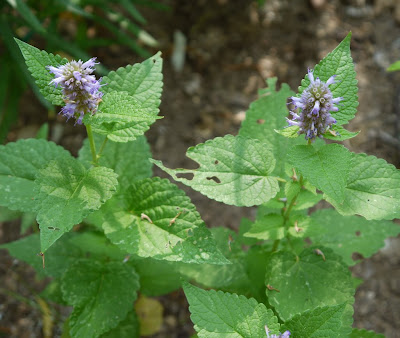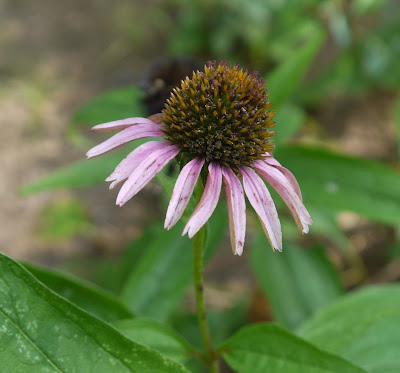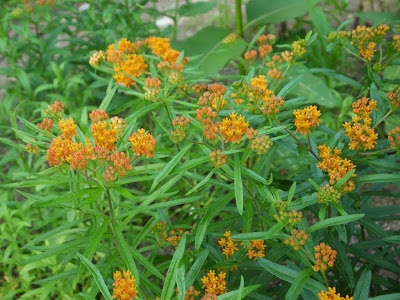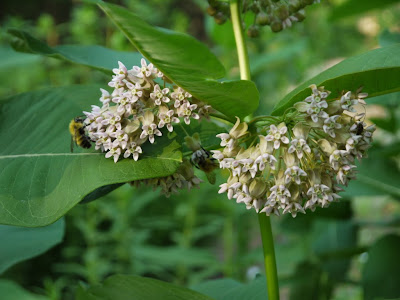I have trouble finding help to weed this garden because what are weeds in normal gardens might be plants here, and what are plants in normal gardens might be weeds here. So I think it might be easier just to show people some of the "weeds" and hope that some volunteers out there would be willing to learn these and help remove them.
 Here's a type of sedum that the Eklunds undoubtedly planted. Not native, so it's got to go. It comes back really quick.
Here's a type of sedum that the Eklunds undoubtedly planted. Not native, so it's got to go. It comes back really quick.
 This is Canadian Clearweed and even though it looks like nettles and is in the nettle family, it doesn't sting (thank you thank you thank you). It grows like crazy in the shady terraces off to the right. Hmm. Maybe we should find a place for it to grow and make it part of the garden. It's native after all. Although here's a funny like from Wikipedia: "It is sometimes grown as a ground cover or for attracting deer." Oh, I just found this interesting video on the weed. The more I think of it, the more I think we should incorporate this one into the garden.
This is Canadian Clearweed and even though it looks like nettles and is in the nettle family, it doesn't sting (thank you thank you thank you). It grows like crazy in the shady terraces off to the right. Hmm. Maybe we should find a place for it to grow and make it part of the garden. It's native after all. Although here's a funny like from Wikipedia: "It is sometimes grown as a ground cover or for attracting deer." Oh, I just found this interesting video on the weed. The more I think of it, the more I think we should incorporate this one into the garden.

Red Clover, found along the walk near the Brown Eyed Susans.

A dense cluster of young Black Swallowwort. This is a vine with leaves that are opposite, shiny, and pointy. Phlox also has opposite leaves, but not pointy.

Here's the Black Swallowwort when it's more developed, including seed pods.
Grass. It comes up all over the Butterfly Bed.
Whatever this thing is called.

This stuff gets everywhere. I tend to call it 'clover' but it's actually Wood Sorrel.
That's right, Forsythia. Not native. There was tons of it growing along the slope, especially up top. We cut it back but of course it keeps coming back.
 This was the hottest summer on record for Bridgeport, and it was also very, very dry. We had no water source and the plants struggled to survive. This Hardy Ageratum, though, not only survived, but thrived.
This was the hottest summer on record for Bridgeport, and it was also very, very dry. We had no water source and the plants struggled to survive. This Hardy Ageratum, though, not only survived, but thrived. The New England Asters are just starting to open up. Their native blooms are a vivid deep purple. They went to seed last year and popped up all over the garden this spring.
The New England Asters are just starting to open up. Their native blooms are a vivid deep purple. They went to seed last year and popped up all over the garden this spring. The Garden no longer has that masses of blooms it had earlier in the year. But if you look around, you'll see blooms here and there. Above is a Harebell, still blooming after months of drought.
The Garden no longer has that masses of blooms it had earlier in the year. But if you look around, you'll see blooms here and there. Above is a Harebell, still blooming after months of drought. The Sneezeweed is just starting to bloom. It was cut back early because it was getting too tall.
The Sneezeweed is just starting to bloom. It was cut back early because it was getting too tall. Ahhh, that's really just a weed. Goldenrod.
Ahhh, that's really just a weed. Goldenrod. The
The  One of the Black-Eyed Susans, Rudbeckia fulgida.
One of the Black-Eyed Susans, Rudbeckia fulgida. I think this is Purple Giant Hyssop, a hitchhiker on some purchased natives. Whatever it is, it went to seed and popped up in various places this year.
I think this is Purple Giant Hyssop, a hitchhiker on some purchased natives. Whatever it is, it went to seed and popped up in various places this year. Here's a cluster of immature Large Milkweed Bugs. That's their real name. They were on the Butterfly Weed, which is related to Milkweed.
Here's a cluster of immature Large Milkweed Bugs. That's their real name. They were on the Butterfly Weed, which is related to Milkweed. Purple Coneflower, still hanging on.
Purple Coneflower, still hanging on. Blanket Flower. After a deep rain about two weeds ago, it put out a handful of new blooms.
Blanket Flower. After a deep rain about two weeds ago, it put out a handful of new blooms. The other Black-Eyed Susan, Rudbeckia hirta.
The other Black-Eyed Susan, Rudbeckia hirta. White Wood Asters, although not very flashy, can be counted on in those super-dry shady areas.
White Wood Asters, although not very flashy, can be counted on in those super-dry shady areas. Here's a Monarch Caterpillar on the Butterfly Weed, bypassing the Milkweed which is right behind it.
Here's a Monarch Caterpillar on the Butterfly Weed, bypassing the Milkweed which is right behind it.












































